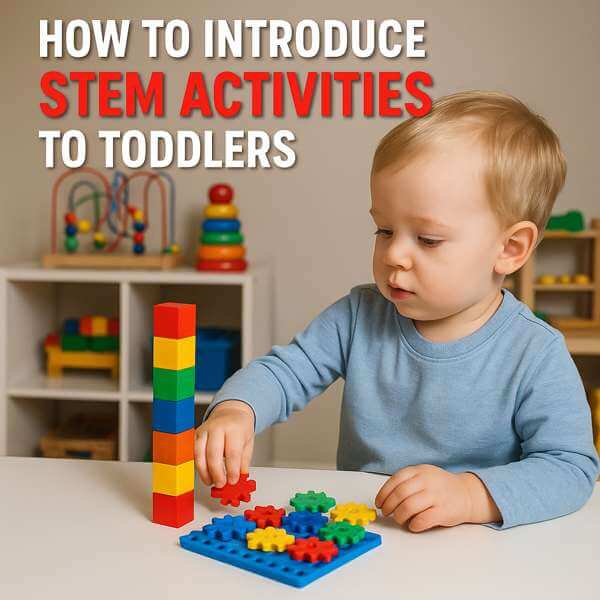How to Introduce STEM Activities to Toddlers
Introducing STEM (Science, Technology, Engineering, and Mathematics) activities to toddlers can be a fun and educational experience. These activities help young children develop critical thinking skills, creativity, and curiosity about the world around them. By engaging toddlers in STEM from an early age, parents and educators can foster a love for learning that lasts a lifetime. This article will guide you on how to introduce these exciting activities to your little ones.
Understanding STEM for Toddlers
![]()
STEM stands for Science, Technology, Engineering, and Mathematics. It is an approach to learning that integrates these four fields. For toddlers, STEM activities are simple and playful. They are designed to spark interest and encourage exploration.
Toddlers learn best through play. Therefore, STEM activities should be hands-on. They should involve touching, moving, and experimenting. This helps toddlers understand concepts better.
Examples of STEM activities for toddlers include playing with building blocks, exploring nature, and using simple tools. These activities teach basic principles of physics, biology, and engineering.
It is important to make STEM activities age-appropriate. This means they should be safe and not too complex. They should match the toddler’s developmental stage.
Parents and caregivers play a crucial role in guiding toddlers during STEM activities. They should encourage questioning and curiosity. They should also provide support and supervision.
Overall, introducing STEM to toddlers involves creating a fun and interactive environment. It is about nurturing their natural curiosity and helping them discover new things.
Why Start STEM Early?
![]()
Starting STEM education early has many benefits. It builds a strong foundation for future learning. Children who engage in STEM activities early are more likely to excel in school.
Early exposure to STEM helps develop problem-solving skills. Toddlers learn to think critically and creatively. They learn to ask questions and find solutions.
STEM activities also promote language development. As toddlers explore and experiment, they learn new words and concepts. This enhances their communication skills.
Research shows that early STEM education can increase interest in science and math careers. It opens up opportunities for future success in these fields.
By starting STEM early, we can close the gender gap in science and technology. Encouraging both boys and girls to participate in STEM activities promotes equality.
In summary, early STEM education sets the stage for lifelong learning and achievement. It equips toddlers with essential skills needed for the future.
Simple Science Activities
![]()
Science activities for toddlers should be simple and engaging. They should allow toddlers to explore and discover at their own pace.
- Exploring water: Toddlers can play with water by pouring, splashing, and measuring. They can learn about volume and buoyancy.
- Nature walks: Taking a walk outside allows toddlers to observe plants, animals, and insects. They can collect leaves or rocks and talk about what they find.
- Color mixing: Using paints or food coloring, toddlers can mix colors to see what new colors they create. This teaches them about color theory.
- Magnet play: Providing magnets lets toddlers discover which objects are magnetic. They can experiment with attraction and repulsion.
- Baking soda and vinegar: Mixing these two ingredients creates a fizzy reaction. Toddlers can watch and learn about chemical reactions.
- Shadow tracing: On a sunny day, toddlers can trace shadows of objects or themselves. This introduces them to the concept of light and shadow.
The key to successful science activities is allowing toddlers to lead. Let them ask questions and make discoveries on their own.
Technology for Little Learners
![]()
Technology can be introduced to toddlers in a fun and safe way. It is important to choose age-appropriate tools and applications.
- Interactive tablets: Many tablets have educational apps designed for toddlers. These apps teach letters, numbers, and shapes through games.
- Digital storybooks: E-books with interactive features engage toddlers and make reading fun. They can touch the screen to hear sounds or see animations.
- Music players: Listening to music or audio stories can enhance auditory skills. Toddlers can sing along or dance to the rhythm.
- Simple coding toys: Some toys introduce basic coding concepts through play. They often involve sequencing actions to achieve a goal.
- Photo-taking: Giving toddlers a simple camera allows them to capture their world. They can take pictures of their favorite things and discuss them.
- Video calls: Talking to family members over video calls can help toddlers connect with loved ones. It also improves their communication skills.
When using technology, it is important to monitor screen time. Balance tech activities with physical play and face-to-face interactions.
Engineering Fun Through Play
![]()
Engineering activities for toddlers focus on building and designing. They encourage creativity and problem-solving.
- Building blocks: Classic wooden or plastic blocks allow toddlers to build structures. This teaches balance and spatial awareness.
- Puzzle solving: Simple puzzles challenge toddlers to think critically. They must figure out how pieces fit together.
- Sandcastles: Playing with sand at the beach or sandbox fosters creativity. Toddlers can design and construct their own sand structures.
- Cardboard creations: Using cardboard boxes, toddlers can create cars, houses, or anything they imagine. This activity inspires innovation.
- Marble runs: Setting up a marble run track lets toddlers explore gravity and motion. They can experiment with different designs.
- Bridge building: Using everyday items like straws or sticks, toddlers can build bridges. This introduces them to engineering principles.
Through engineering play, toddlers learn to test ideas and solve challenges. Encourage them to try different approaches and see what works.
Math Made Easy for Toddlers
![]()
Math activities for toddlers should be enjoyable and relatable. They should incorporate counting, sorting, and pattern recognition.
- Counting games: Use toys or snacks to practice counting. Toddlers can count as they line up items.
- Shape hunt: Go on a shape hunt around the house or yard. Identify circles, squares, and triangles in everyday objects.
- Pattern making: Create patterns using colored blocks or beads. Toddlers can replicate or extend the patterns.
- Measuring fun: Use measuring cups or rulers to compare sizes. Discuss which items are bigger or smaller.
- Number songs: Sing songs that involve counting, like “Five Little Ducks.” Music makes learning numbers fun.
- Money play: Introduce coins and pretend shopping. Toddlers learn about value and exchange.
Math activities help toddlers develop logical thinking. They learn to recognize numbers and understand basic mathematical concepts.
Creating a STEM-Friendly Environment
![]()
Creating a STEM-friendly environment encourages toddlers to explore and learn. It involves setting up spaces where they feel free to experiment.
- Designate a play area: Have a specific space where STEM materials are accessible. Keep it organized and inviting.
- Provide diverse materials: Offer a variety of tools and resources, like blocks, books, and art supplies.
- Encourage open-ended play: Allow toddlers to use materials in creative ways. Avoid giving too many instructions.
- Celebrate curiosity: Praise toddlers for asking questions and trying new things. Support their interests.
- Model enthusiasm: Show excitement for STEM activities. Join in the play and share your observations.
- Limit screen time: Balance digital activities with hands-on experiences. Ensure a healthy mix of both.
A supportive environment fosters a love for STEM. It empowers toddlers to be confident learners and explorers.
Conclusion: Nurturing Young Scientists
![]()
Introducing STEM activities to toddlers is a rewarding journey. It lays the groundwork for a lifelong passion for learning.
From simple science experiments to creative engineering play, each activity contributes to a child’s development. They gain valuable skills that prepare them for the future.
Parents and caregivers play a vital role in this process. By providing opportunities and encouragement, they nurture young scientists and innovators.
Remember, the goal is not to master complex concepts. Instead, it’s about sparking curiosity and joy in discovery.
With the right approach, STEM can be a delightful part of a toddler’s daily life. Let’s inspire the next generation of thinkers and problem solvers.
Keep exploring, keep questioning, and most importantly, keep having fun!





